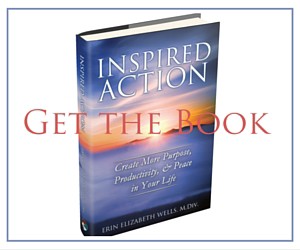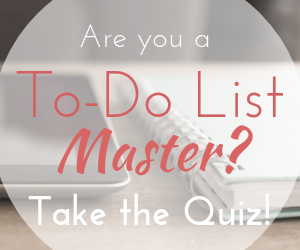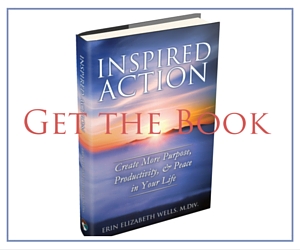Recently, I went to hear Marie Forleo speak on her book tour, and one quote of hers continues to stick with me, “What if fear is the GPS for where you most need to go?”
Seriously, what if?… what if that project, that experience, that challenge that you’ve been mulling over, dreaming about, fantasizing over… is exactly where you most need to go. Is there something you’ve been resisting? Is there something you’ve been feeling daunted to tackle? Then you’re going to love this excerpt of Chapter 3 from my book, Inspired Action: Create More Purpose, Productivity, and Peace in Your Life.
While I know many location-independent entrepreneurs have far more courage to push beyond their comfort zones than the average person, I also know that many of us still find ourselves caught in resistance from time to time. That’s why I decided to offer this excerpt to help you get “unstuck” if resistance has been rearing its head in your world.
Dissolving Resistance
Every road to every dream begins with your decision to walk it and the action of taking the first step. However, so many of us get daunted by the idea of the journey. We dwell on our fear of the obstacles and challenges that might appear miles down the road, and our imagined monsters become larger and scarier, locking us into what I call scared-bunny mode. We become frozen in inaction.
We are not rabbits, however, and most of our predators exist primarily in our own minds. But that doesn’t mean the predators don’t exist. Our greatest predator, writes Steven Pressfield, is resistance:
Resistance is the most toxic force on the planet….It prevents us from achieving the life God intended when he endowed each of us with our own unique genius.
We each have work that we are here to do. We have gifts that we are uniquely able to give to others. When we allow resistance to defeat, discourage, or delay us, we are harming not only ourselves, but also the entire world, including friends, family members, and co-workers who might need what we have to give. Others may benefit directly from your life’s work, or perhaps they will simply be inspired by seeing you live it.
Either way, resistance is the monster to be conquered.
What can you do to conquer your fear and dissolve your resistance? As I stated earlier, the road to any purpose, goal, dream, or outcome starts with two things:
- The decision to commit yourself to the path.
- A plan of action that shows you the first step to take.
Task 1: The Decision to Commit
In my experience, such decisions are not made once and finished. Indeed, with resistance gnawing at your heels, it is easy to end up mired and frozen again. So, try turning your decision to commit into a daily practice. Each day, lock resistance back into its cage by recommitting to your purpose.
How this daily practice of recommitment manifests in your life will be unique to you, but here are some ideas to get you started:
- Evoke the energy of joy and commitment within yourself. Then repeat a series of affirmation statements during your morning routine— in the shower, in front of a mirror, or before your first sip of coffee. What could you say? I am connected and committed to my purpose. I am focused on living my purpose fully today. Best of all would be to create and use your purpose connection button, which we cover in Chapter 4 of Inspired Action.
- Engage in a brief daily reflection or journaling session on future possibilities. What will living your purpose make possible for you or others? How can and will you bring more value, beauty, and goodness to your life and to the lives of those around you?
- Meditate. Turn your purpose statement into a mantra, or draw warm energy from the earth and from Spirit to feed yourself and your purpose.
- Make a declaration upon getting up each morning: “I love my life, and I am here to ______.”
Task 2: The Action Plan
The second part of dissolving resistance involves creating a plan of action and taking the first step that will help you shift your focus from the awe-inspiring end of your journey to its very simple beginning. As Antoine de Saint-Exupéry said, “A goal without a plan is a wish.”
When climbing a mountain, if you continuously look at the top, you’re likely to trip over a lot of rocks. Therefore, the fastest and surest way to actually get to the top is to start with the first few steps. Here are some questions to help you get started:
- What is the exact next step? Drill down and make it specific. Your next step should be a specific task that ideally takes 5 to 10 minutes, but definitely takes no longer than an hour. Examples: “Call John re: repairs”; “Email Stephanie to schedule meeting”; “Research hotels in Florence”; “Order copy of Inspired Action for Jessica.”
- Based on your calendar, could you take that next step today? If not, pick a specific day this week when you can commit to that step.
- Is there anyone who can help you on your journey? Support and encouragement from others can help you get moving again when the resistance monster looms. Who could be on your team, either actively working with you toward your goal or serving as your cheering and coaching section, providing accountability and encouragement as needed?
As you tackle these questions, remember this key idea: It’s best not to focus on possible problems with your journey right now. Address them when (or if) they arise.
Could your plan be much more elaborate and involved? Sure. But the essence of dissolving resistance is taking simple and continuous action by asking yourself, “What is the exact next step? When will I do it?” The best way to build momentum is to take one such step toward your intentional future each day. Once you get into a rhythm of action, then more big picture advanced planning might be appropriate, but for now conquer resistance through simple, continuous action.
According to Adam Markel, former CEO of the personal development training company Peak Potentials, there are two kinds of habits: habits of doing and habits of not doing. If resistance has held you entrapped in the latter, then it’s time to start developing the former. For more information and ideas on developing new habits, take a look at Inspired Action’s Chapter 14: Habits: The Power of Patterns.
I will conclude with an insight that my mother shared with me about getting her dissertation finished. The project felt so big and daunting that she avoided getting started. Her key to moving forward was deciding that the first step would be simply to sit at her desk for 15 minutes. She didn’t have to do anything. She just needed to commit to getting her “butt in the chair.” From that small step, the further actions of reviewing research, writing notes, and drafting small sections of the dissertation became much easier over time.
What is your “butt-in-the-chair” action? What can you do to just start showing up for your purpose and life’s work in the world?
Next Actions
- During the next two weeks, practice identifying and scheduling the next actions for your purpose-driven plan. Afterward, reflect on your progress. Has taking action become easier? Is resistance still getting in the way? If so, break down the tasks into even smaller steps, or ask someone to be your partner in the process.
- When you find your mind mired in what-ifs or thoughts about possible obstacles or challenges, tell that little voice in your head, “Thank you for sharing” and refocus either on your purpose statement or on your exact next action. Even better, practice asking more empowering questions of yourself. You can learn more about the formula for empowering questions in Chapter 34: Leading by Example.
- Momentum is your best friend when countering resistance. Make taking action on your purpose a regular event in your life, either daily or weekly. Plan it ahead. On what day(s) could you take action? For how long? Imagine how adding that piece would feel in the flow of your day. The more predictable taking action becomes, the easier the momentum is to sustain.
- Make an audio recording of your affirmations to play as you brush your teeth or drink your coffee in the morning. Always begin by evoking a positive emotion before you listen to them; for instance, open yourself to feeling committed or unstoppable. Use this practice as your talisman of recommitment to keep your mind focused on your purpose and goals.
If this excerpt from Inspired Action has been helpful to you, then pick up a copy of the book today. It provides 50 short, actionable chapters that can help you connect with greater meaning and purpose and develop the productivity systems to put your purpose into action each day.




